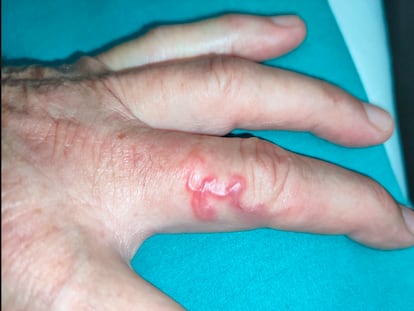Alicia Rojas, microbiologist: ‘Climate change is expanding malaria to areas of the US’
The Costa Rican scientist is calling for greater investment in parasitic diseases which affect one billion people in the world, mainly in Indigenous and vulnerable populations

There were three options: study piano, architecture, or microbiology. The last option did not completely convince Alicia Rojas, 35, only because she knew that she would have to learn parasitology. The young woman, who was 17 years old at the time, was not attracted to the idea of spending hours examining feces in a laboratory. Eighteen years later, however, she is one of Latin America’s top experts in the area.
“Parasites are fascinating, they live for years outwitting the host’s immune system,” she says over a video call. Recently awarded the Anneke Levelt-Senger Award, Rojas is concerned about the lack of funding in her specialty and the brain drain of Latin American scientists. “Research can change the lives of a billion people,” she says, referring to those affected by parasitic diseases in the world. “Mostly people from low socioeconomic backgrounds and indigenous people. That’s why not so much is invested in it.”
Rojas, however, has dedicated his entire career to it. She studied in her native Costa Rica and in Israel, diving into the world of worms that mainly inhabit and infect animals, and trying to simplify and improve the diagnosis of these pathologies. She discovered a new species, spirocerca vulpis, and is also one of the most important voices in research into the DNA of parasites and their variants depending on geography.
A month ago, she came across an investigation that went viral across the world. “Live worm measuring eight centimeters found in the brain of an Australian woman,” the headlines ran. This parasite, common in pythons, was found for the first time in the brain of a human. “I found it very curious that this case became so viral, because there have been similar cases of other parasites in humans,” she says. “In any case, I like that it has attracted attention because all publicity is good publicity, especially in the area of parasites, which is not discussed that much.”
It has been less than half a century since parasites stopped infecting humans in urban areas in the way they once did. Sewage and water purification made life difficult for these pathogens. But they continue to affect very low-resource areas as well as pets and livestock. “Before, parasites that invaded the gastrointestinal system were very common, causing diarrhea, intestinal pain or anemia… This was remedied in the cities, but there are forgotten areas where it is still common.”
Costa Rica is no exception. In her native country, Rojas collaborates in a social action program led by doctors Alberto Solano and Javier Mora in which, together with students from various areas of study, they visit Indigenous, migrant and socioeconomically vulnerable communities to raise awareness about parasites, diagnose those affected and provide treatment.
“This is not a problem that is only happening in Africa or Asia. In the tropics of Latin America, one in three people is affected by parasites,” she adds. The treatment of intestinal parasites is extremely simple. A dose of tablets and follow-up consultation. “You start to think… If it’s so affordable and so simple, why do cases continue to occur around the world? In addition to affecting vulnerable populations, there is also poor management of the diagnosis. The solution to both problems is the same: more research.”
Although the doctor rules out the possibility of a pandemic due to a parasite (“the mode of infection is much slower”), she says that it is more than likely that outbreaks or even epidemics will begin to occur in places where these pathologies are not endemic. She puts this down to global warming, explaining that rising temperatures mean that more and more areas have the conditions for parasites to spread, i.e., warm temperatures.
“As a result, we will see in a few year’s time, many more cases of malaria and Lyme disease,” explains Rojas. “Climate change is already expanding malaria to temperate areas of the United States.” In June, U.S. health authorities confirmed five cases of malaria in Florida and Texas, the first locally acquired cases in 20 years, according to the Centers for Disease Control and Prevention (CDC). “There’s an upward trend, because weather conditions are changing rapidly.”
Sign up for our weekly newsletter to get more English-language news coverage from EL PAÍS USA Edition
Tu suscripción se está usando en otro dispositivo
¿Quieres añadir otro usuario a tu suscripción?
Si continúas leyendo en este dispositivo, no se podrá leer en el otro.
FlechaTu suscripción se está usando en otro dispositivo y solo puedes acceder a EL PAÍS desde un dispositivo a la vez.
Si quieres compartir tu cuenta, cambia tu suscripción a la modalidad Premium, así podrás añadir otro usuario. Cada uno accederá con su propia cuenta de email, lo que os permitirá personalizar vuestra experiencia en EL PAÍS.
¿Tienes una suscripción de empresa? Accede aquí para contratar más cuentas.
En el caso de no saber quién está usando tu cuenta, te recomendamos cambiar tu contraseña aquí.
Si decides continuar compartiendo tu cuenta, este mensaje se mostrará en tu dispositivo y en el de la otra persona que está usando tu cuenta de forma indefinida, afectando a tu experiencia de lectura. Puedes consultar aquí los términos y condiciones de la suscripción digital.
More information
Archived In
Últimas noticias
New York enters the era of Zohran Mamdani
Welcome to the post-religion era: The idea of Christianity as the absolute truth has become obsolete
‘I thought you would like it’: The risky sexual practice popularized by TV shows and TikTok
The digitalization of tourism: ‘They promise experiences and gave us the worst possible one’
Most viewed
- Sinaloa Cartel war is taking its toll on Los Chapitos
- Reinhard Genzel, Nobel laureate in physics: ‘One-minute videos will never give you the truth’
- Oona Chaplin: ‘I told James Cameron that I was living in a treehouse and starting a permaculture project with a friend’
- Why the price of coffee has skyrocketed: from Brazilian plantations to specialty coffee houses
- Silver prices are going crazy: This is what’s fueling the rally











































